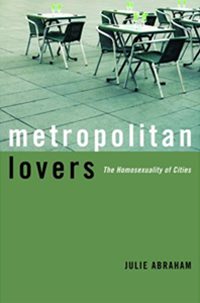The cultural mythologies at work behind our understanding of homosexuality and urbanity.
A professor of literature and LGBT studies at Sarah Lawrence University, Julie Abraham launches an exploration of the complex relationship between queers and the city in her latest book Metropolitan Lovers (upress.umn.edu). From Baudelaire’s Les Lesbiennes to Ann Bannon’s Bebo Brinker, Abraham traces these cultural associations and teases out the assumptions that shape the way we think about urban spaces and our place in them.
Did you come across any major surprises in your research?
What I thought I would find is the kind of more familiar story about how gay people have come to the city, or queer people or lesbians and gay men have come to the city and formed communities, and the city has been enabling for them. And instead what I found is the story we tell ourselves about queer people and about cities that’s sort of fundamental to both…while it’s certainly a historical fact, it’s also very importantly an idea which has been used to organize our understandings of what it means to be gay or lesbian and what it means to be urban for the last 150 years.
So, how does that function culturally?
Well, I think even still it allows to flourish a certain, very limited understanding of lesbians and gay men, and a fairly limited understanding of cities. And so people are endlessly writing these articles about how queer people are growing up, they’re moving to the suburbs, but that is predicated on this idea that adults live in the suburbs and people who don’t grow up, including queer people, live in the city. The United States during the post war period developed a real opposition between a kind of adult family life, an adult complicated life, and a life in the city. And it was an idea that was used to propel suburbanization and assimilation…and also an idea that was used to help foster racial divisions because African Americans were not welcome in the suburbs and were intensely over-identified with the city, particularly at that moment.
Have modern representations of queer people affected that at all? Has there been a Brokeback Mountain-effect with the way people are thinking about rural places versus cities?
Well, Brokeback Mountain got a tremendous amount of publicity because of the stunning revelation that men were having sex with other men someplace that wasn’t the city, right? But at the same time the popularity of the movie, which allows everybody to rediscover this fact, even if on one level the film breaks the stereotype and says, well, yes, there are men having sex out in rural areas, it also reinforces the stereotype because the minute you have to start discussing it—even if what you’re doing is saying it’s not true—you’re acknowledging that we’ve all thought it was true for a really long time. So, you’re kind of backhandedly reinforcing it.
How do you think that the rulings on gay marriage in places like Iowa and New Hampshire—places where there aren’t really big urban centers—effect the way people are thinking about homosexuality and cities?
On the one hand I think the fuss about these rulings in Iowa and Vermont and stuff, is a product of shock that these states with no major cities and therefore, by assumption, with no gay people, could be making these radical moves. Oddly enough, the coasts become the emblematic cities and Iowa becomes this rural place, which is ridiculous also, that Iowa shouldn’t have lots of gay people and/or that a positive vote on gay marriage should only depend on the presence of lots of gay people. I mean, the assumptions just keep building. It must be very irritating to queer people in Iowa, and everybody else in Iowa, too. [Laughs]
Your study challenges the assumption that the homosexuality of the city is always male. Can you talk a little bit about that?
There’s really been a back and forth, historically. At certain moments gay men have been more visible … at certain moments lesbians have been more visible. But I think beginning in the ’70s with the development of commercial urban centers that were very visible to straight people as opposed to just visible to queer people … gay men in the cities of North American suddenly became very visible, particularly white gay men. And all of the lesbians and men and women of color became less visible, and that pattern is something that we still see today. It’s probably to do with the much more commercial nature of white gay male culture as opposed to lesbian culture. Gentrification was a real focus of accounts from the late ’70s and early ’80s and white gay men fit that model much more effectively. Lesbians have historically been less visible as gentrifiers, even if they have also functioned that way. And African American gay men and lesbians who already lived in cities or who were already over-identified with cities, whether they lived there or not, weren’t useful as figures in a cultural mythology that tied queer people to gentrification. So, a lot of factors are operating, but I really wanted to point to the braided nature of the history of lesbians and gay men in relation to cities, and not leave that assumption standing.
